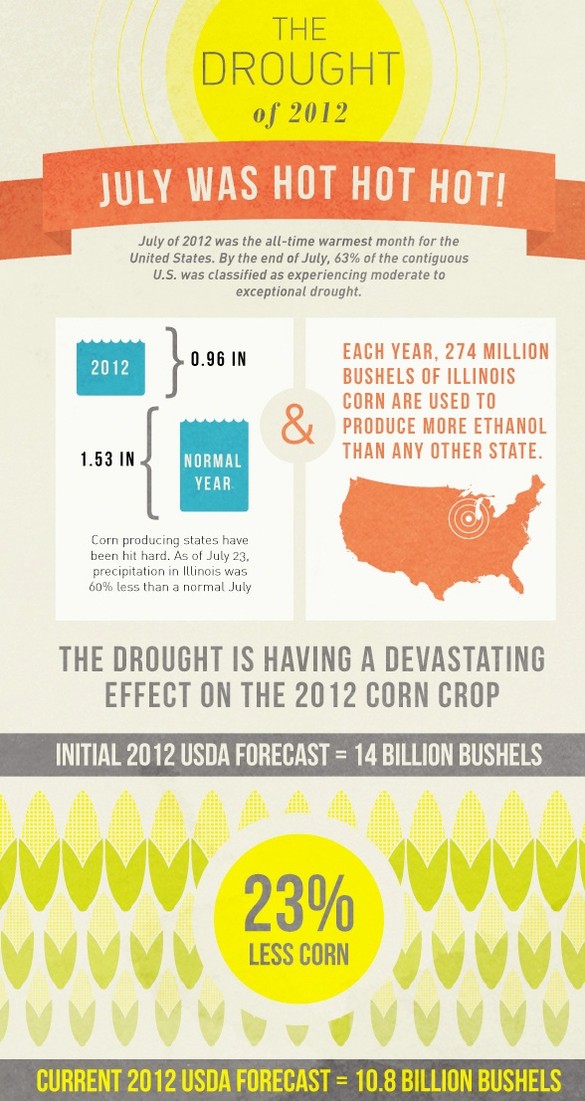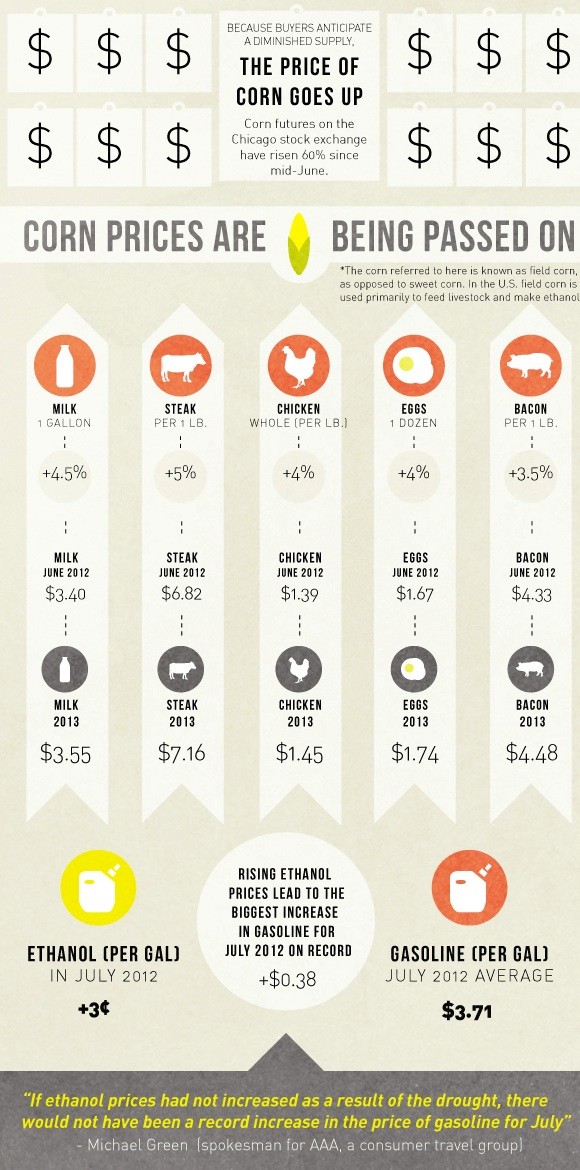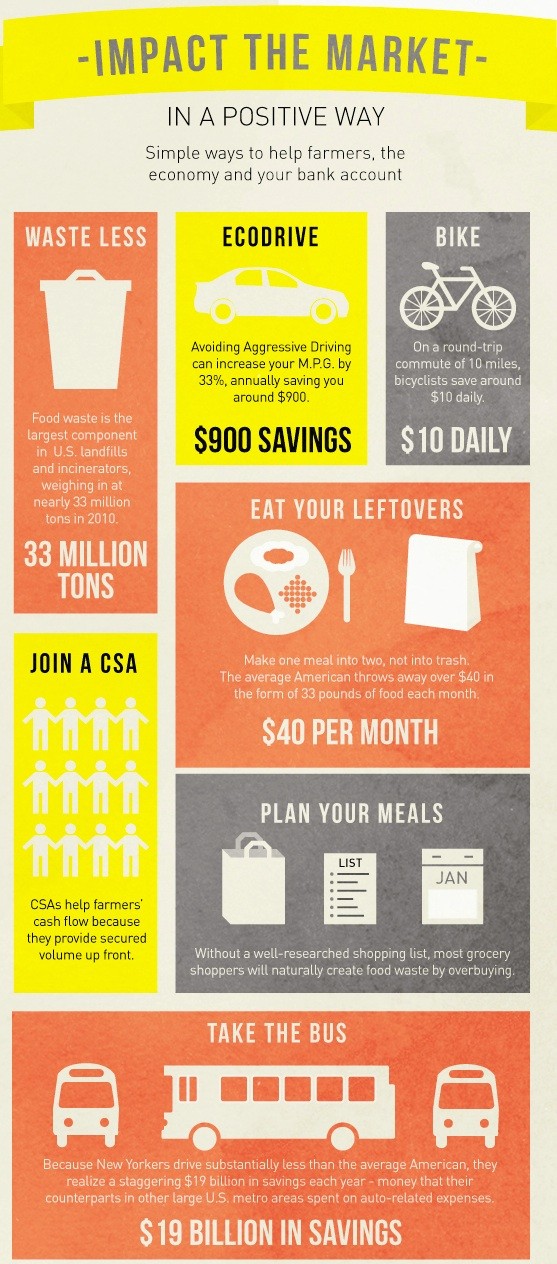I grew up on farms in Iowa and Wisconsin, surrounded by a
family of farmers and agricultural workers, all of whom grew
corn. I have never heard any farmer say, ďWow, we got the
perfect amount of rain this year.Ē Itís never perfect, and
farming is a tough business. There have been droughts before,
and it looks like there will certainly be more droughts in the
future. However, the summer of 2012 has been historic in several
ways:
● July was the all-time warmest month on record in the United
States.
● Corn yields are predicted to be the lowest in 17 years.
● Corn futures touched a record high of $8.49 a bushel on August
10.
● July saw a 17-cent jump in the national average gasoline
price--the biggest increase for that month on record.
● The United Nations Food and Agriculture Organization reported
the largest monthly jump in its cereal price index, up 38 points
(17%) from June and only 14 points below its all-time high
registered in April 2008.
So whatís the difference between 2012 and other years of
drought?

For one, this summer has seen record-breaking heat and dryness, especially in Americaís breadbasket. The drought came at a particularly bad moment in the corn growing cycle, resulting in a crop that is likely to be diminished by around 23% this year. This decrease in supply of course increases demand, increasing the price of corn, which gets passed along to industries that use corn (mainly ethanol producers and livestock and dairy farmers). Along with retailers, affected farmers and manufacturers absorb as much of the price as possible before they must pass the cost along to consumers in an already struggling economy. (See projected prices in the graphic.)
A second major difference is the amount of corn we grow for ethanol these days. There is a huge debate over the current ethanol mandate that I aim (rather optimistically) to steer clear of in this post. But when a drought knocks out 23% of the harvest, that deficit has to come from somewhere. The current federal renewable-fuel standards require 13.2 billion gallons of corn ethanol to be blended with gasoline this year. That takes 4.7 billion bushels of corn. In a year where 10.7 billion bushels is an optimistic estimate for the total national corn crop, that means nearly 44% of this yearís corn harvest would have to go toward ethanol.

Ethanol producers and grain farmers have to make a living and
so do livestock and dairy farmers. The people and businesses on
both sides of that equation are important to our country and our
economy. Unfortunately, ethanol and grain now are competing with
livestock and dairy farmers for the same reduced quantities of
this yearís corn crop. The difference is that ethanol and grain
farmers have a federal mandate on their side.
Historic droughts have a way of exposing weaknesses in our
agricultural system. In this case, itís the tie between food and
fuel. Put simply, we take nearly half of our corn crop and use
it to produce 10% of our gasoline supply. This is a huge shift.
As you can see in the graph, in 1989, 4% of domestically used
corn went to ethanol, and 93% went to livestock feed, corn seed,
and food products. By 2011, about 45% of the crop went to
ethanol, with 55% going to feed, seed, and food.
The government may relax federal renewable-fuel standards in light of the drought and they may not. A number of farmers are already culling their herds because they canít afford to feed them. This results in more meat on the market in the short term, but higher prices for the consumer in the long term, and fewer small family farms.

Ethanol isnít getting out of 2012 unscathed either. The high price of corn affects ethanol producers, and therefore the price of gasoline. Ethanol makes up 10% of gasoline in the U.S., on average, and is one of the factors that contributed to Julyís record gasoline price increase. That is not to demonize ethanol--the U.S. grows more corn than any other country, so making some ethanol with corn helps us be less dependent on volatile foreign oil. But at what point do we become too dependent on one type of ethanol? When we start turning nearly half of our corn harvest into fuel, we donít leave much margin for drought and other factors. Agriculture must be flexible and able to change quickly, like the weather.
It seems that diversification may be the key here. After all, consumers can arguably avoid high food prices in the short term by changing their eating habits, but that doesnít help farmers. Farmers can pasture or feed their animals, but both of those options are compromised by the drought. Corn-based ethanol is currently the only biofuel we mix with gasoline in the U.S., but it doesnít have to be in the future. Possible alternatives to corn-based ethanol--like advanced biofuels that run on drought-resistant switchgrass, agricultural waste, and manure--are on the horizon, but arenít yet viable on a wide scale. Electric and natural gas cars are on the market today, but they are not yet commonplace.

As individuals, itís easy to feel helpless, but we can always
work to impact the market by decreasing our consumption of oil
and gasoline using simple efficiency techniques like
eco-driving, taking public transportation, and biking. Simple
conservation methods like composting, planning meals, and eating
leftovers make a difference in reducing food waste and saving
money on food.
Support farmers by buying their products. If you love cheese,
keep eating cheese, even though it may be a bit more expensive
next year. Save money by reducing the food you waste instead.
Get to know your local farmers, buy local, and join a CSA. These
small changes may sound basic, but every great movement has had
a simple and straightforward message. Americans are great
innovators and problem solvers, not to mention great farmers.
The drought of 2012 is an important wake-up call. It has
highlighted for us our dependency on an industrial agriculture
system that may not be flexible and nimble enough for the
changes we face in the future.
